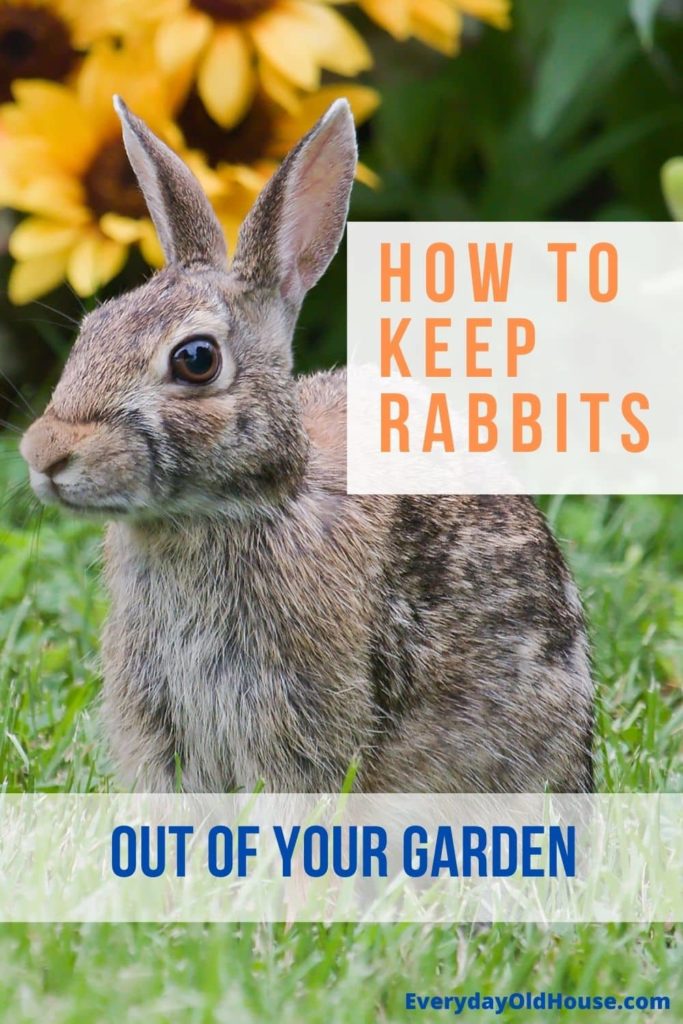Last Updated on January 25, 2024
During the pandemic fall of 2020, I went a bit crazy and planted over 100 tulip bulbs in the small garden that runs alongside the north side of our home. Spring came and and my tulips came up like crazy! But there was a problem – my sprouting tulips were under attack by nettlesome rabbits! It was time to research (and share with you) how to protect tulips from critters and defend our beautiful gardens.
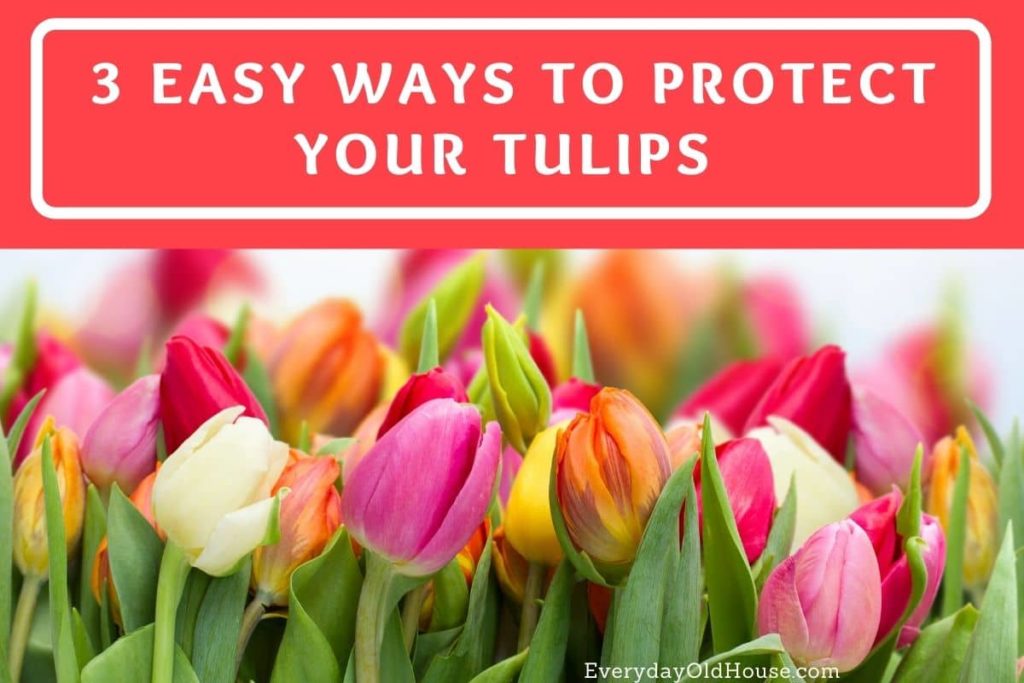
This post contains affiliate links, including but not limited to, Amazon Associates. As such, I earn from qualifying purchases. Full disclosure located here.
Which Critters Eat Tulips?
First, let’s know thine enemy. Who eats tulips? Apparently, A LOT of animals. The biggest offenders of tulip-eating include (but not limited to….):
- Deer
- Rabbits
- Groundhogs (aka woodchucks)
- Voles
- Squirrels
- Chipmunks
That’s a lot of critters! Yikes! And they don’t all attack tulips the same way.
For example, some critters (ex: chipmunks and voles) are strict burrowers and dig up tulip bulbs from underground. Meanwhile others (ex: rabbit and deer) wait for the bulbs to sprout and target the green shoots and flowers. And then there are others (ex: groundhogs) who aren’t picky and love all parts of the tulip – above and underground.
What does this mean for you and me? That means every part of the tulip must be protected – Yikes again!
How To Protect Tulips From Critters
There are 3 easy ways to deter those pesky deer, rabbits and rodents from eating your tulips:
- Physical Barriers
- Odor and Taste Repellents
- Companion Planting
1. Physical Barriers
Erecting a physical barrier using chicken wire or mesh is the most effective ways to keep pesky critters away from your tulips. Physical barriers easily protect 1) bulbs in the fall and 2) flowers, shoots, and leaves in the spring.
Tulip Bulbs
Newly planted tulip bulbs are extremely vulnerable to rodents who LOVE to burrow for bulbs, such as squirrels, voles, chipmunks, groundhogs. I protected my bulbs last fall using a method recommended by This Old House Magazine. They suggested laying down mesh or chicken wire on top of the soil after planting blubs. As per the photo below, I placed deer mesh (the same mesh I used to protect my blueberry bush) over the tulip bulbs and secured the mesh with lawn staples.
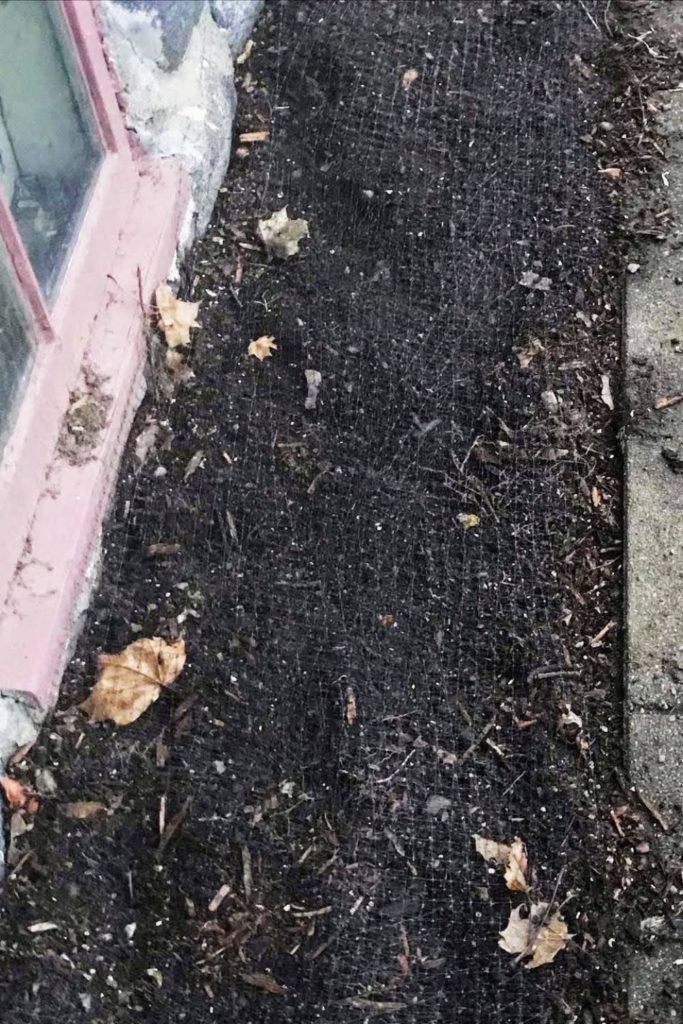
And I’m thrilled to report that the mesh protected the bulbs through the fall and winter!
Mesh Alternative
Not into covering the soil with mesh or chicken wire? Here’s another physical barrier that might protect your bulbs from burrowers. Some gardeners swear by adding gritter material to the soil (e.g. gravel, stone, etc.. even egg shells!) to discourage digging.
Tulip Flowers
Fast forward to spring and my tulips are popping up! However, obviously that mesh needs to be removed to that the shoots and leaves doesn’t get tangled.
However, that exposes the young shoots, leaves and flowers and makes them vulnerable to aboveground foragers.
Luckily, there are a few easy (and inexpensive) solutions to create a simple fence around your tulips. The downside of this method is that the tulips are obscured by the fencing (versus the other two ways), but fencing is the most effective way.
Here’s two ideas I’ve tried since 2021:
1. DIY Mesh Fence
One is to simply create a fence with the same mesh used in covering bulbs. But this time secure the fencing horizontally with wooden or metal posts.
As you see below, the shoots are coming up and are protected! The deer mesh is being held up by plant supports and secured with lawn staples. It’s not the prettiest look BUT it did the job.
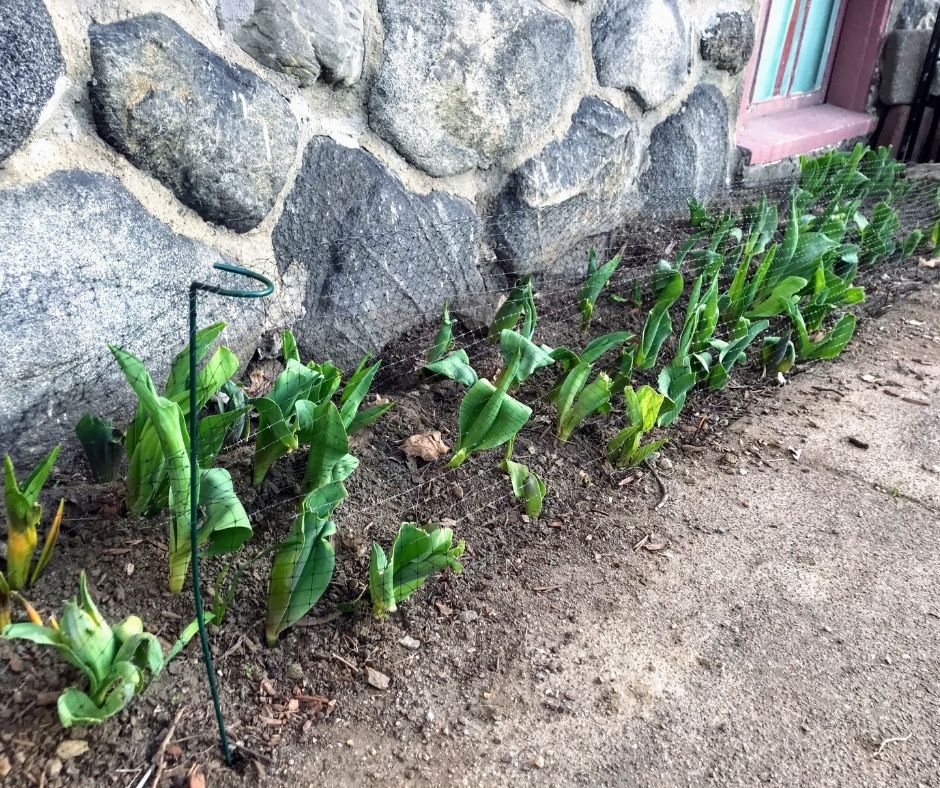
Later in the season when the tulips bloomed I realized that the plant supports were too short and that the rabbits could get to the flowers, so I re-did the garden with tomato supports.
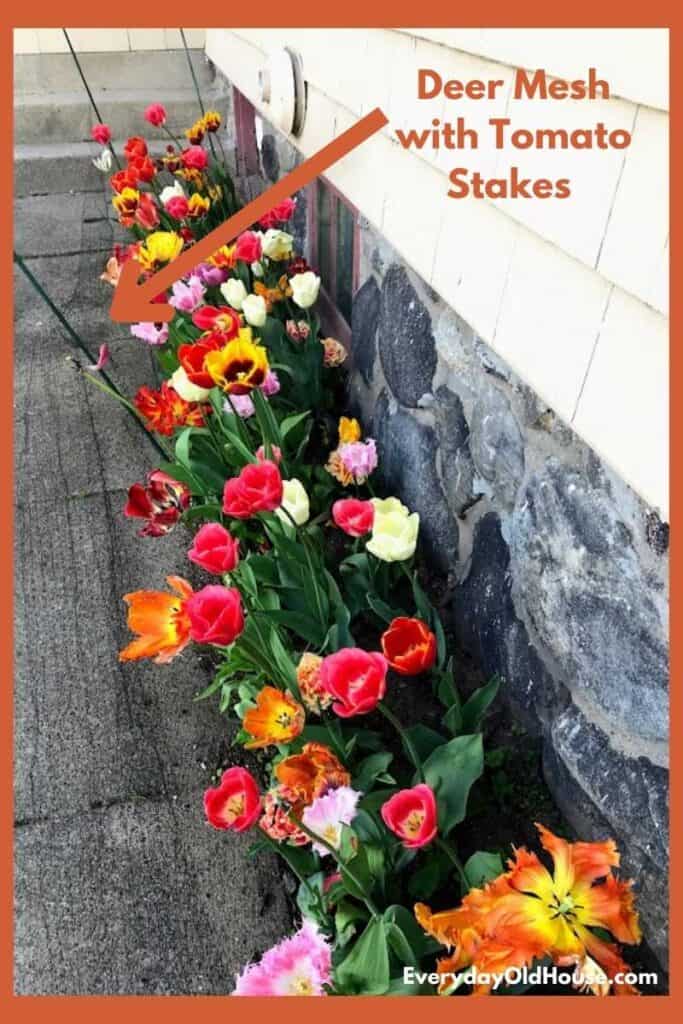
Need further proof? Here’s a snapshot taken from my night video camera (model no longer available, but like this one). No midnight snack for you Peter Rabbit!
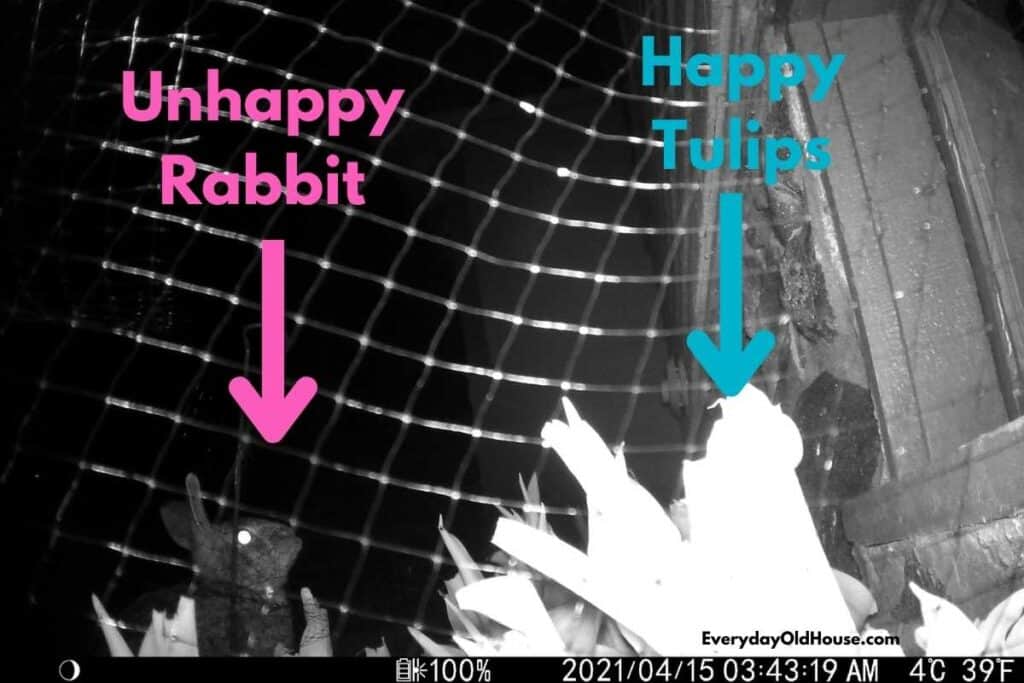
2. No Dig Fence
Another option is to install a no dig fence. I’m a HUGE fan of no dig fence – so easy to install. We use have no dig fence along our backyard. As per the photo below, I had a few extra panels so I decided to try it last year with the tulip garden and it worked.

But admittedly I think this particular style of no dig fence took away from the beauty of the tulips. A bit too tall and bulky. Ultimately, I prefer the above mesh option.
However, there are a few no dig fence options on the market (especially Zippity’s Bella Enclosure) that are low enough to show off a tulip garden’s beauty while still protecting them.
Additional Tips to Protect Tulips from Critters
If you enclosure your garden via physical barrier, here’s a few tips:
- Fencing must be tall enough to stop critters
- Rabbits need at least 3 feet high
- Deers need at least 6 feet high
- Mesh should have openings no greater than 1″ by 1″ (although our no dig fence was slightly wider and still dettered rabbits)
- Metal mesh is preferred for fencing. Rabbits can chew right through plastic and fiberglass mesh (although that wasn’t my experience)
- For maximum defense against burrowing:
- Bury fence at least 3-6″ deep
- If fence material is malleable, bend the buried portion away from plants
2. Odor and Taste Repellants
Sometimes fencing isn’t the preferred alternative. Why plant tulips to enjoy their beautiful colors only to cover them up with fencing? Odor and taste repellents produce a smell (or taste) that repulses rodents and encourage them to turn their nose up at the tulips in your garden beds.
There is a HUGE list of odor repellents to protect tulips from critters, many of which are natural and FREE (or relatively low cost) and probably already hanging around your house. Or commer
Honestly, I didn’t have the best experience with many of these. BUT they might work for you!
Human Hair Cuttings
After a haircut or a beard trim, collect the hair clippings and scatter them around your plants. Apparently the scent of human hair repels critters. And if you don’t have human hair, pet fur will also suffice.
During the pandemic, I started cutting my husband’s and kids’ hair, and actually am getting good at it! Three years after the pandemic and I’m still cutting my childrens’ hair. So for us, human hair is a readily available source.
Human Urine
This sounds kind of gross, but reportedly effective. It you live in an area where your neighbors aren’t located too close, this might be a way to, uh, shall we say, relieve, two problems at once? ?
Note that apparently men’s urine works, not women… sounds a bit discriminatory, doesn’t it? ?
Bar Deodorant Soap
Another inexpensive option is putting a smelly bar of deodorant soap (like Irish Spring) in your garden bed. Cut the bar of soap into several pieces and put into pantyhose or sock and tie closed with twine or string. Hang the pouch from a plant support stake in the garden bed. For added effectiveness, add shavings in the soil.
Talcum Powder
Critters also stick their noses up at the smell of talcum powder. Sprinkle talcum powder over leaves and flowers. Although I’m curious if this will method make your tulips look like they have dandriff…..
Homemade Repellents
Many critters are disgusted by the pungency and taste of garlic, hot pepper, vinegar and onions. Using ingredients already in your kitchen, you can mix a concoction that will make pests turn up their nose and run the other way.
Effectiveness of homemade concoctions vary by homeowners. Some swear by their recipe, others find their tulips still annihilated. One year I decided to try my own homemade rabbit repellent for tulips concoction. (Honestly, it wasn’t a huge success, but it might for you!)
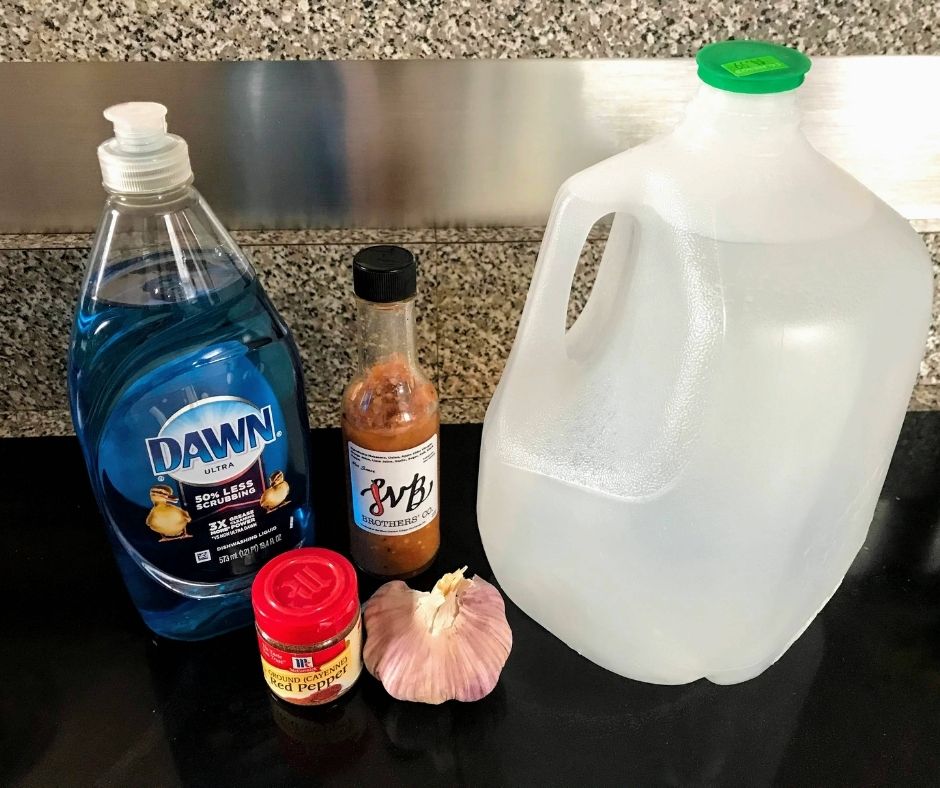
Commercial Repellents
There are a host of commercially available rodent repellents. A downside of these repellents versus homemade versions is that they are more expensive, but homeowners tend to achieve better results.
Note that there are a few reports of pets eating these repellents and getting sick (even though marked as safe), so pet owners should proceed with caution.
Blood Meal
Blood meal is dried animal’s blood (usually cow) that is processed into a powder that serves two purposes. One, critters despise the smell of it and will stay away. Second, it serves as a nitrogen-rich organize fertilizer to boost vegetable growth. Be sure to follow directions when applying – more require when mixing with topsoil or compost.
3. Companion Planting
The third way to avoid critters from eating those “tasty” tulips is to plant other flowers known to have an unappetizing taste. The goal is companion planting is to strategically place plants that pests dislike next to plants they love to discourage feeding.
Personally I haven’t tried this with my tulips. As you can see from the above photos, I didn’t save any room for additonal spring plantings. But I’ve had success using this companion planting method in my vegetable and herb garden to deter rabbits from feasting.
Related Post: 10+ Vegetable and Herbs Rabbits Won’t Eat from Your Garden [Free Printable]
Here’s the most common flowers to plant with tulips to deter critters include:
- Daffodils
- Ornamental onions
- Snowdrops
- Snowflakes
- Bleeding hearts
If you try this method and are successful, please let me know – I’d be happy to add your experience to this post!

Wrapping Up
Of the 3 ways to protect tulips from critters, the most effective way is through fencing. However, fencing can hide tulips and prohibit fully enjoying their beauty. While the other two ways (i.e. repellants and companion planting) tend to be less effective (in my experience), they do provide a unobstructed view of your tulip garden.
Related Posts
Want to be the first to know about new posts? Be sure to follow me on Pinterest, Facebook, Instagram or Twitter of even Etsy! Or better yet… Subscribe below!
My monthly (admittedly sometimes more, sometimes less….) emails are like receiving a unexpected letter from an old friend WITHOUT needing to put on your slippers and walk out to your mailbox…. See? I got ya, my friend!)
[Note: My posts are proudly connected to these amazing link parties full of DIY ideas and inspiration!]










